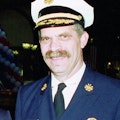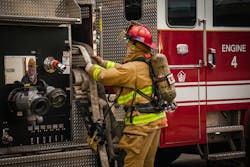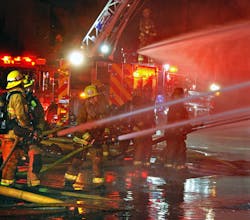Fire Studies: Locate, Confine and Extinguish
Smoke came from the eaves and attic vents of a two-story, single-family dwelling. The occupants huddled together on the front sidewalk. The young children cried, and the parents were obviously upset. They looked at their worldly possessions being threatened by fire.
On arrival, the captain of Engine 24 asked the parents whether everyone was out of the building and gathered information that they knew about the fire. The owner believed that the fire started in the attic.
Engine 24 stretched their 1¾-inch hoseline to the interior as Truck 19 placed their ladders in anticipation of opening the roof.
There was only a light haze of smoke on the interior. The pull-down attic stairway was located in the second-floor hallway. The captain ordered the truck on the exterior to remove the vents in the front and rear of the attic. The hoseline was placed at the top of the pull-down stairs and operated from there. The stream of water quickly knocked down the visible fire in the attic; the nozzle was changed to a fog pattern that pushed smoke to the outside through the opening where the vent was removed.
The attic was large enough for the captain and two firefighters to operate. The potential problem was the pull-down stairs only would support one firefighter at a time.
The truck brought in debris cans. The smoldering rubble was placed in the cans and wet down to prevent re-ignition. The debris cans were taken to the exterior.
The electrical panel was checked. The circuit breaker for the attic was tripped, which indicated a possible cause of the fire.
By controlling the amount of water and performing hydraulic ventilation, damage to the home was minimized. There was no need to open the roof, because the fire was contained to the stored material. Most likely, only the vents needed to be replaced.
Problem-solving
Firefighters must mitigate the problems that confront them. To accomplish their goals, success only can occur by predictability. This requires ample training and set procedures. Knowing each individual’s duties allows every member to integrate his/her actions into a team approach. The training that’s required can be accomplished efficiently through the engine and truck company concept. Although each company is a separate unit, it must be part of a larger organization at each emergency scene.
The proper implementation of engine and truck (or ladder) company assignments is essential for successful emergency scene operations. The teamwork that’s needed demands close coordination of efforts. To be effective, firefighters must interact. Through training, they learn to get the right thing done at the right time. In fire departments that staff truck companies, there is a distinct difference between the duties of an engine and of a truck. In areas where no truck is assigned, another unit must assume the duties that are performed by the truck company. These assignments can be given to a rescue company or another engine company.
The use of specialized apparatus—for example, quints, tower ladders and water towers—demands that specific duties be assigned. Personnel who operate this equipment might perform either engine or truck duties or a combination of those duties.
The goal of recruit training and ongoing training should be that crew have the skills to perform all fireground functions.
A typical fireground standard operational guideline (SOG) has the first-due company, Engine 1, make forcible entry and advance a hoseline into the burning building. Engine 2 secures a water supply for Engine 1 and performs ventilation. Engine 3 places a backup hoseline to support Engine 1 and performs search and rescue. Rescue or Squad 1 assumes the duties of the rapid-intervention team (RIT).
Should a truck company be assigned instead of a third engine, the changes would be minimal. Engine 1’s duties remain the same. Engine 2 secures the water supply and places a hoseline to back up Engine 1.
Truck 1 performs ventilation and search and rescue. Rescue or Squad 1 is the RIT.
An SOG is based on numerous factors. A prime consideration is the amount of staffing that’s on each apparatus. Career departments that have minimum staffing requirements can implement guidelines that are written with their staffing as a consideration. If staffing fluctuates, as it does in many departments, the incident commander (IC) needs to prioritize assignments.
Engine company operations
Engine company operations provide firefighters with the water to control and extinguish fires. The engine company typically consists of an apparatus that has a pump, a hosebed, and compartments to carry tools and equipment. Specialized apparatus can be utilized as an engine company.
The staffing on an engine company can vary. National standards recommend a minimum staffing of four firefighters for career departments. The actual staffing is strictly dependent on local factors. Staffing levels will dictate what can be accomplished.
The engine company is responsible for locating the fire, confinement, extinguishment, securing and delivering a water supply to the incident scene, and utilizing the water supply for control and extinguishment.
Locating the fire
Locating a fire can be a simple task. It might be unattended food on a stove, a smoldering mattress that was removed to the exterior by the occupants or rubbish that’s burning on the highway.
Locating the fire can be complex when confronted with a multistory building that’s heavily charged with smoke and smoke detectors activated on multiple floors.
The first part of locating a fire is the initial information that’s given to dispatch. This can be in the form of an address and additional data. Dispatch should transmit this information when the companies are dispatched. When arriving on scene, the address will be confirmed or changed if it isn’t the dispatched location of the fire.
Units gain additional information on scene through size-up. This information can come from:
- visual indicators, such as fire visible in a window, door or roof area
- occupants or bystanders
- alarm systems that pinpoint the fire areas
- sprinkler systems that were activated
It is recommended that the first-arriving company officer do a 360-degree walk-around of the fire building, utilizing a thermal imaging camera if available. The latter helps to locate a fire if no flames are visible.
Information is power. The more that you know, the better prepared you are to address the problems that confront you.
Confinement
The aim is to confine a fire to as small of an area as possible. Confinement must consider the six sides of the fire. This includes the four walls and above and below the fire.
You must consider what is attempted against what can be accomplished. What staffing is available? What is the risk to firefighters? In determining strategy, a reasonable assumption must be made on the size of the area to which the fire can be confined. Incident analysis through a comprehensive size-up allows the IC to assess the situation and utilize experience to anticipate problems/occurrences. It must be a proactive approach, considering the potential for immediate fire spread. What reasonably can be accomplished? What resources are needed?
After the situation is determined, make some predictions. When confronted with a minor fire, you must predict what the conditions will be in 5, 10 or 15 minutes. As the complexity of an incident increases, the time frame considerations can increase to 10, 20 or 30 minutes. On a major incident, predictions involve time ranges of 30 or 60 minutes or longer. Realize that not only must future problems be anticipated, but you must ensure that additional resources are requested should those potential problems develop.
The contents of the fire building, the type of construction, the presence of fire protection features within a building and the resources that are available all affect confinement.
Construction features, such as fire walls and fire doors, assist in containment. Other building characteristics, such as balloon-frame construction, air shafts, and unprotected horizontal and vertical openings, permit extension of fire to other areas of the building or exposed structures. A fire that occurs in an area of a building that’s compartmentalized allows containment by utilizing the construction features in conjunction with good extinguishment methods.
Studies on firefighting ventilation practices and tactics that were conducted by Underwriters Laboratories and the National Institute of Standards and Technology found that effective confinement of fires that are in one- and two-story dwellings can be accomplished with a coordinated offensive-exterior attack, immediately followed by an offensive-interior attack to achieve full extinguishment.Extinguishment
Containment is followed by extinguishment. The time that’s required to accomplish this function is related directly to the size of the fire area, the number of hoselines that are deployed and the amount of overhauling that’s required. A room-and-contents fire could be confined and extinguished simultaneously. Complex incidents could require a fireground detail that could take days or weeks before complete extinguishment is achieved.
Water supply
Securing a water supply is an initial concern of the engine company. If operating in an area that’s supplied by hydrants, locate the nearest hydrant that will provide an adequate supply.
Many SOGs call for the second-due engine company to provide the first-due engine with a water supply. When possible and with enough time and personnel, the first-due engine can secure their own water supply. This initiative ensures a continuous water supply and, with the second engine company securing their own water supply, provides multiple water sources at the incident scene.
In nonhydranted areas, securing a drafting site or utilizing a water tender operation is required. It might be possible to set up a relay operation from an adjoining hydrant area or a drafting site.
Large-diameter hoseline allows large volumes of water to be moved from the source to the fire. If long distances are encountered, a relay pumping operation that involves multiple engines in the relay can be employed.
An evaluation of the available water supply must be made. If there is no preplan or prior assessment of the water supply, it must be an immediate concern. Assignment of a logistics section chief or a water supply group ensures that this important facet is given adequate attention. Once assigned, the amount of water that’s needed must be determined by conferring with the IC.
In areas that aren’t serviced by hydrants, it must be determined whether a relay operation from a nearby lake or river can be set up. If strictly a water tender operation, dump tanks should be set up in locations that allow easy access and egress for the water tenders. The number of water tenders that are available must be considered, along with the needed fire flow.
The available flow can be calculated by determining water main size and available hydrants and/or the proximity of rivers, lakes and other large supplies of water. Adding the volume of the water tenders and multiplying the time that’s needed for these units to load and unload their water determines the amount of water that’s available. (Five 3,000-gallon water tenders that require a round trip of 10 minutes to load and unload theoretically could supply 15,000 gallons of water in 10 minutes, or 1,500 gpm. This leaves no margin for error, and attempting to fully utilize 1,500 gpm would be a short-sighted approach.)
Utilizing the water supply
The amount and type of fire dictate the size of the hoseline that’s used to attack the fire. The 1½- and 1¾-inch hoselines are the workhorses of the fire service. Their weight and maneuverability in confined spaces and their ease of handling have proven overwhelmingly successful on fires that occur in residential properties. It seldom is necessary to stretch a larger hoseline into dwelling units.
However, these hoselines can prove to be ineffective or less effective when fighting fires in commercial properties that contain a heavy fire load or large, noncompartmentalized areas. There is a tendency to use 1½- or 1¾-inch hoselines on all interior operations, regardless of the size of the structure or its contents.
Fully relying on 1½- or 1¾-inch hoseline might mean the difference between success and failure of an offensive attack. The reluctance to utilize 2½-inch hoseline seems to stem from the fact that engine staffing levels in most departments necessitate the combining of multiple companies to place a 2½-inch hoseline into operation. The benefit of using the 2½-inch hoseline is that the larger volume of water provides a greater cooling effect and quicker knockdown.
When the fire still is controllable by an interior attack, the IC should consider his/her options when dealing with a fire in a large-area structure or one that contains a heavy fire load. Size-up must be used to evaluate the incident and to determine whether 1½- or 1¾-inch hoseline can make a difference and whether there is enough time to utilize 2½-inch hoseline as the initial attack line. The IC may order 1½- or 1¾-inch hoseline for the initial company(ies) to allow them to quickly apply water in an attempt to make rescues as well as in an attempt to control a fire. The next arriving companies then can utilize 2½-inch hoseline to back up or replace the smaller hoseline. This tactic gets the smaller and easily handled hoselines into operation quick enough for containment. The speed of a quick-attack concept might make the difference between gaining initial control of the fire or having to use an immediate defensive attack because of the additional time that’s needed to deploy the 2½-inch hoseline. The time that’s required to utilize 2½-inch hoseline can be reduced by frequent training sessions to maintain firefighter skill levels.
Firefighting Tactics Studies
Underwriters Laboratories (UL) and the National Institute of Standards and Technology (NIST) have performed groundbreaking studies on the effect of tactics on residential fires.
“Analysis of the Coordination of Suppression and Ventilation in Multi-Family Dwellings” by UL’s Firefighter Safety Research Institute (UL FSRI) includes door control, flow paths, and the positive results of implementing interior hoselines as well as exterior hoselines for fire control and knockdown prior to entry into a structure.
These studies can be accessed online. Studying their content and implementing their findings in training exercises should be part of every fire department’s training program.
For more on these studies, see the “Coordinated Fire Attack” supplement that’s included in this issue of Firehouse Magazine.
About the Author

James P. Smith
JAMES P. SMITH, was a Firehouse contributing editor and a retired deputy chief of the Philadelphia Fire Department. He is an adjunct instructor at the National Fire Academy and the author of the fourth edition of the book "Strategic and Tactical Considerations on the Fireground," which was published by Brady/Pearson.

